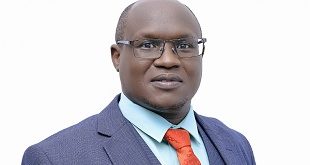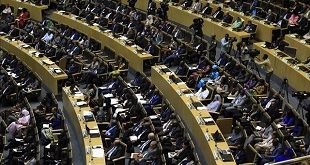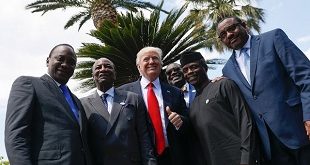
By Mubatsi Asinja Habati
Somalia war enters new phase after Mogadishu is captured
On the night of Saturday August 6, the al-Shabaab fled the Somali capital Mogadishu under the cover of darkness. Witnesses described truckloads of heavily armed Shabaab fighters driving away under the cover of darkness and the beleaguered residents of the capital pouring into the streets to cheer and jeer their departure.
The departure of al Shabaab means that for the first time in 20 years, Mogadishu is under the control of government forces without any loyalty to a specific clan. About 48 hours later, on Monday August 8, the Somali President, Sheik Sharif Ahmed, arrived in Kampala at the start of a shuttle diplomacy trip that took him to Dar es Salaam for a meeting with President Jakaya Kikwete on August 10.

More significantly, 10 days after al Shabaab fled, on Tuesday August 16, the Eritrean President Isaias Afewerki arrived in Kampala for meeting with President Museveni. The departure of the Islamic militant group that had controlled most of Mogadishu for the last five years may have happened abruptly even for the regional leaders. Their comings and goings revealed the frantic efforts by regional leaders and, in the case of Afewerki, reposition themselves to the new reality. Afewerki has been accused of funding the terrorist activities of al-Shabaab.
That President Museveni was at the centre of the repositioning is not surprising. The departure of al Shabaab marks a turning point in the UN-backed African Union mission, Amisom, in that country. The EU and U.S governments have supported Amisom with logistics. However, although all these forces contributed to pushing al-Shabaab out of Mogadishu, the bulk of the boots on the ground are Ugandan and the spirit driving the force is President Museveni.
Museveni’s intent to defeat the al-Shabaab intensified after the militants boasted about masterminding the July 11, 2010 Kampala twin bombings which killed over 79 people. Soon after this, Amisom forces began conventional engagement of the militants.
On August 8, Museveni’s office, after his meeting with the Somali president at his country ranch in Kisozi, issued a buoyant statement in which it claimed the al Shabaab were “flushed out of the city following heavy clashes with Transitional Federal Government (TFG) forces backed by African Union peacekeepers”. Most reports before this had indicated that the al-Shabaab had retreated in an orderly fashion in what was seen as an internal tactical decision.
But the Museveni statement said the withdrawal followed successive offensives in which the TFG and Amisom captured three strategic locations in Mogadishu to protect aid workers providing assistance to over 100,000 people affected by severe famine and were taking refuge in the city. Uganda’s Chief of Defence Forces, Gen. Aronda Nyakairima, has also said the Amisom capture of Mogadishu did not come cheaply. The UPDF lost at least 20 soldiers in the offensive a week before the al-Shabaab retreated from Mogadishu.
Whatever the motivation or manner of the Al Shabaab departure, when he spoke in Dar es Salaam, Somalia’s President Sharif Ahmed, vowed to flush them out the whole of Somalia.
“As long as they are in Somali territory, even an inch, I will not rest,” he told journalists, “Our determination is to clear them out.”
The Somali president has in the past been criticised for not pushing firmly enough to remove the scar of al Shabaab, which is accused of links to al Qaeda and fomenting terrorism in the region, from the face of Somalia. Now that he has spoken, many people are waiting for action.
The comments of Hassan Shire, a Somali activist who has lived in exile in Uganda for a long time are typical: “The capture of Mogadishu means 70 percent of the war in Somalia is won,” he told The Independent, “what needs to be done is to fight the al-Shabaab outside Mogadishu so as not to allow them to regroup because it is now easier to defeat them, it’s an opportunity to deny the al-Shabaab a fallback position.”
Leaders of the Somali Community in Uganda, such as Abdullahi Hajji Ahmed, the vice chairperson of the community, told The Independent that in addition to the militarily offensive, the TFG/Amisom should step up use of the mass media to deny al-Shabaab recruits. They say al-Shabaab have focused on brainwashing young Somalis to believe they are fighting a holy war against American backed invaders.
Not defeated yet
Despite pulling out of Mogadishu, the al-Shabaab still control a large part of rural Somalia including towns, ports and airports. Their financial backbone in form of taxes, extortion, piracy and foreign support especially from al-Qaeda links in Yemen continue to make the Shabaab a force to reckon within, according to the recent report by the UN Monitoring Group on Somalia. The report says the al-Shabaab with backing from Eritrea collect between US$70 million to US$100 million per annum from taxation in areas they control. Observers of the Somalia war say the al-Shabaab could resort to terror and guerilla war tactics.
In fact, although they announced they were pulling out of Mogadishu, the al Shabaab did not leave the war-torn city altogether. Hours after they announced their pullout, serious fighting between the militants who the Amisom spokesman described as “stay behind parties” and the government forces continued and thousands of people fled.
The situation/war in Somalia is complicated by drought, famine and a weak government which relies on foreign backing than on its internal strength. The TFG lacks the military capacity to safeguard Mogadishu without the help of Amisom forces.
Sources say the al- Shabaab was weakened by a leadership rift over how to react to the current famine, which UN says is worse than the one of 1991/92 that struck Somalia. It is said Shabaab leaders of Somali origin, led by Mukta Robo, argued that aid agencies should be allowed in to help the suffering communities. But another leader, Godane, from the breakaway republic of Somaliland where there is no war did not want relief aid in Somalia.
According to a Somali analyst living in Uganda, the divisions made al- Shabaab’s pullout of Mogadishu inevitable since Godane and Mukta Robo control the bulk of the forces. Together with the diminished financial support from local and foreign funders, loss of support from the local populace, as more youth shun their ideology as foreign to Somalia, compounded the problem for al-Shabaab.
“They pitted themselves against the elders who command a lot of respect in Somalia as they had demanded either two camels or a boy from each household for recruitment which was refused,” said Lt. Col. Paddy Ankunda, the spokesman of Amisom. As a result, they failed to get recruits and defections to TFG widened.
Sweet victory
Lt. Col. Ankunda says Amisom would pursue the Shabaab if the peacekeepers are given more resources and troops because TFG forces are already on the frontline with al-Shabaab in some areas of rural Somalia and that this is an opportunity to restore the state of Somalia which has not been with a functional government since 1991 when Siad Bare was ousted.
“TFG has allied forces down south and in the central (Somalia) who have been doing a good job. They captured towns of Luq, Afmadow, Ceel waaq, Belet Hawo and Garbaharrey and have not lost them to the insurgents since. Obviously, Mogadishu was Phase 1. The next phase is to spread out if Africa and the international community mobilise resources and troops. I think the world has an opportunity to restore the state of Somalia now than ever before,” Ankunda said.
The al- Shabaab are said to be retreating to Somalia regions of Bay and Bakol, Lower Shebelle, Galgadud and Lower Jubba particularly to Kismayo.
For now, although the capture of Mogadishu is not an end to the war, the Amisom forces must be excused if they celebrate it.
Four years ago when the first Ugandan army contingent of Amisom entered Somalia in March 2007, the Somali government was under siege. The Amisom troops were under pressure to guard the airport which was under constant militant fire, the presidential villa. Almost daily, they battled to retain control of the strategic Maka-Almukarama road, an essential route for supplies for the TFG and Amisom.
The soldiers lived in heavily fortified bases and moved under very heavy armour. Slowly the AU forces began taking control of other parts of Mogadishu from the al-Shabaab. In July 2010, they secured the area around the presidential villa, parliament, and what remained of the top hotels like Urubah and Juba Hotels. In June Lt. Col. Paddy Ankunda, told The Independent that government forces were controlling 8 of the 16 districts of Mogadishu as the al-Shabaab controlled 3 and 5 were being fought for.
In the days leading to the al Shabaab withdrawal, Amisom forces had laid siege of the Bakara market. They were, however, reluctant to overrun the market which was a local major financial source for the Islamic fighters. When it became impossible for them to hold onto the market, the al-Shabab announced withdrawal from Mogadishu.
Hussein Abdu, a Somali young businessman, who has constantly been to Somalia since the deployment of AMISOM has felt the changes every time he has been to Mogadishu.
“In 2008 when I first returned to Mogadishu we would go shopping under military escorts and curfews were common. My 2010 trip to Mogadishu was different. We would move 5 km to the usual shopping centre without military escorts at certain hours of the day. In May this year I did not need security guards to go shopping and with the retreat of al-Shabaab one can hope the security situation in Mogadishu to greatly improve,” he says.
It is also significant that on the same, the first flight ever of relief aid arrived in Mogadishu. It carried over 34 tonnes of assorted items. The office of the United Nations High Commissioner for Refugees already had many offices in the famine-ridden country. But it usually moved supplies by land.
Now that Mogadishu is secured and aid can more quickly reach the hungry Somalis, businesses, NGO offices, and embassies are likely to follow. But the TFG must also widen its focus its attention to capturing the rest of unliberated part of Somalia.
Next move
While in Uganda, Somalia President Ahmed Sharif repeated his request for more troops. To pursue the al Shabaab, the Somali government will need more than the 9000-strong AU forces provided by Uganda and Burundi. The Amisom mandate also needs to be changed. This would require UN Security Council approval and possibly take months of deliberations. Over the same time, the al Shabaab could be planning and re-strategising and the rifts within their ranks that have weakened them might be mended.
The UN Security Council approved the deployment of 12,000 “peacekeepers” in Somalia. To date, however, only Uganda and Burundi have 6,000 and 3,000 respectively on the ground. Other countries like Nigeria and Ghana which promised troops in 2007 are yet to deliver.
Uganda’s Maj. Gen. Fred Mugisha, AMISOM Force Commander, says deploying additional 3000 troops to bolster the Ugandan and Burundi contingents is now more urgent than before following the al-Shabaab retreat from Mogadishu.
“Our forces now have to cover a much larger area of the city and we risk being overstretched. I appeal to our international partners – on whom we rely – to expedite the deployment of the 3,000 extra troops already authorised by the Security Council as a matter of urgency, so we achieve the mandated force strength of 12, 000,” Gen. Mugisha said.
In Sept. 2010 President Museveni told the UN Security Council visiting team that he was ready to deploy 20,000 troops in Somalia provided he was given the necessary logistical support.
The AU backed his proposal and appealed to the Security Council to raise the mandated strength of the Amisom force to 20,000 troops.
 The Independent Uganda: You get the Truth we Pay the Price
The Independent Uganda: You get the Truth we Pay the Price


